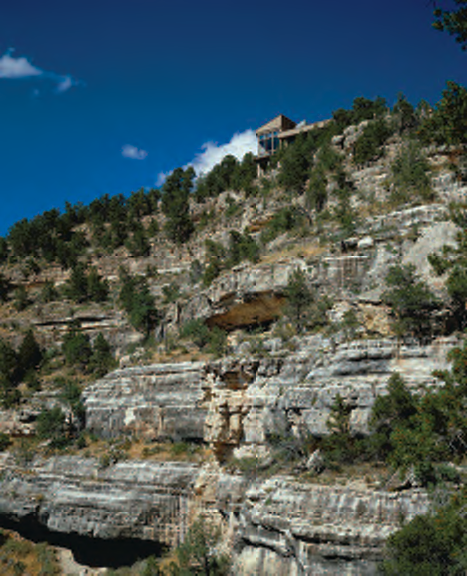DESTINATION Walnut Canyon

Walnut Canyon Dwellings Reveal the Hardscrabble Sinagua Indian Life
FROM A.D. 1150 TO 1250, about 200 Sinagua Indians lived in a canyon 10 piney miles east of Flagstaff. They farmed, hunted and traded with settlements from California to the Plains and into Mexico. Instead of building their homes above the canyon, or near the creek flowing through it, they moved into weathered limestone alcoves halfway down the steep 400-foot mountainsides. With stone “roofs” already there, they added rock walls with low doorways and smoke holes. Today those cliff dwellings attract 150,000people a year to Walnut Canyon National Monument. Visitors can view the ruins from the rim and up close. The easiest footpath, the level .7-mile Rim Trail, offers a magnificent overlook of the canyon. Two ranger-led hikes, two to three hours each, go down into a side canyon to a historic ranger's cabin and through ancient farmlands.
Then there's the popular and infamous Island Trail, with its 240 steps down to - and back up from-a string of ruins. Fortunately, it comes with a railing and benches. The .9-mile trail passes two dozen rooms, some of which hikers can enter.
“It's a nice walk,” said Karl-Heinz Maier, a fitlooking German tourist who had just climbed back up the steps.
“It's... easy... going... down. Hard... coming up,” gasped a returning redfaced woman too out of breath to say more.
The Island Trail attracts all ages, but some overestimate their ability to handle the 7,000-foot elevation and the exertion. “We have two to three 'carry-outs' a year,” Chief Ranger Kim Watson said, referring to hikers hauled back up on litters.
Why did the Sinagua people build on the mountainsides? According to Park Service archaeologist Ian Hough, “They probably didn't want to waste the tillable soil up top, which they needed to grow corn, beans and squash.” Plus, added Watson, they could go up to the rim and down to the creek easily by following natural geological breaks and game trails. “It's not magic. It's logical,” he said.
On the way down the Island Trail-not just coming back up-visitors should rest on a bench or flat-topped boulder,watching for wildlife and imagining what living there was like. My first impression was how noise seemed to carry forever-laughing hikers downtrail, the squawking of turkey vultures soaring on the thermal currents and the chirping of unseen birds in the thick trees. Because of how the sun hits different parts of the canyon, its microclimates mimic a trek from upper Sonoran cacti in warmer locations to conifers and Douglas firs in cooler ones. Box elders and Arizona black walnut trees, the canyon and creek's namesake, grow in the creekbed, which fills with water only after rains.
Sitting on a bench, I thought about the Sinagua. Averaging about 5 feet 6 inches tall, they wore loincloths and fringed skirts. They picked vegetables; chased deer, bighorn sheep and rabbits; and made mats and sandals out of yucca fibers. They built dams for irrigation and terraced land to save precious soil. They used their dwellings for cooking and sleeping. Peering into those empty rooms, I saw smoke-blackened walls and ceilings, and-1 think-handprints on the clay-plastered walls. By the time the site became a national monument in 1915, souvenir hunters had plundered the artifacts. Those remaining ended up in various archives, and a few can be seen in the visitors center, including metates and manos, stone tools and the simple brown-andred pottery the Sinagua made. Exhibits reflect their lifestyle and trading expertise. The Sinagua swapped baskets, piñon nuts, sunflower seeds and obsidian for turquoise, rock salt, copper bells, pipes and figurines.
Artifacts still pop up, though. “Recently, while mapping the rooms, I moved a rock and found a turquoise pendant on a yucca fiber,” said Hough. Two turns in the trail reveal panoramic views of three levels of ruins. Another stunning vista summarizes part of the Sinagua's story. The San Francisco Peaks, where they lived in pithouses before Walnut Canyon, soar to the northwest. Anderson Mesa, their home after Walnut Canyon, stands to the northeast. At one viewpoint, I wondered why the Sinagua left this pretty canyon. Hough said that perhaps overpopulation or climate changes caused the move. The Hopi, who consider the Sinagua their ancestors, believe that moving settlements to better locations was not unusual, or mysterious, for the Sinagua.
Climbing leisurely back up the Island Trail, I passed a hiker hurrying down, counting the steps. He'd just hit No. 40. “This is easy,” he said. “Just wait,” I told him, laughing. “You may be counting benches and flat-topped boulders on the way back up.”
Already a member? Login ».